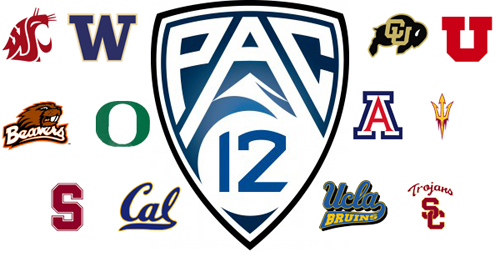The Pac-12 Networks are moving to an office complex in the East Bay, a mere 35 miles from their decade-long headquarters in downtown San Francisco.
In terms of cost and practicality, the new home is a world away from the digs on Third Street.
Bishop Ranch, a 600-acre mixed-use community in the city of San Ramon, will house the networks’ production equipment and staff starting this summer.
The Pac-12 declined to reveal details of the lease, but the move is expected to produce massive annual savings in occupancy costs — money that can be returned to the campuses as part of the annual distributions.
The conference side of the operation (executives and administrators) is moving to a remote-work environment, allowing the Pac-12 to leave San Francisco entirely.
“The decision to replace the downtown San Francisco headquarters with a small production facility outside of the city will result in millions of dollars in additional money that will be distributed to our members on an annual basis,” commissioner George Kliavkoff told the Hotline (via email).
“Additionally, the new production facility will allow us to continue to produce live events and additional programming at a world-class level.”
The future form of the Pac-12 Networks seemingly depends on the outcome of the conference’s media rights negotiations, which are expected to conclude early this year:
— The linear networks could be dropped in favor of a digital-only existence once the current distribution contracts (with Comcast, DISH, etc.) expire in the summer of 2024.
— Football and basketball could disappear from the programming lineup and move entirely to the Pac-12’s major network partners.
— The Pac-12’s technology and infrastructure could be licensed to Amazon or Apple, which have entered the sports broadcasting space but lack production capabilities of their own. (NBC produces the NFL’s ‘Thursday Night Football’ for Amazon; MLB Network does the same for Apple’s broadcasts of ‘Friday Night Baseball.’)
But clearly, the conference intends to stay in the media business in the next phase of its existence — and save money in the process.
How much? We can craft a rough estimate.
The Pac-12’s most recent financial disclosures, for the 2021 fiscal year, show an occupancy expense of approximately $7 million for the San Francisco office.
The cost of the San Ramon facility isn’t publicly known, but a random search for Bishop Ranch commercial property on the website PropertyShark.com shows office space available for $3.65 per square foot per month.
The Pac-12 has leased 42,000 square feet — enough to handle production needs but significantly less than its 114,00-square-foot home in San Francisco.
That works out to $1.8 million annually in rent, an approximate savings for the conference of $5.2 million (excluding the one-time costs associated with the move).
The duration of the lease is not known. But if, for example, the Pac-12 plans to sign a five-year media rights deal and the agreement with Bishop Ranch tracks with that timeframe, the difference (compared to life in San Francisco) potentially could reach $25 million over the contract cycle.
That savings would be returned to the 10 universities as part of the conference’s annual media distributions and, finally, end one of the most controversial issues in recent Pac-12 history.
The conference moved into the San Francisco office in 2012 under former commissioner Larry Scott and will have paid more than $75 million in rent by the time it exits the space.
Upon taking charge in the summer of 2021, Kliavkoff made no secret of his desire to move out and scale down.
Nine months later, he announced conference-side operations would shift to a remote-work environment, with the Pac-12 Networks production studios relocating to an undetermined facility once the San Francisco lease expired (in the summer of 2023).
With the help of a commercial real estate firm, the conference spent several months identifying a location that could handle the production facility — with all the electrical and connectivity requirements — along with the command center used for game operations and instant replay.
The Pac-12 considered leaving the Bay Area altogether but ultimately determined a less expensive space outside San Francisco proper was the best option.
There is no reduction in staffing associated with the move. Because many employees were not considered likely to relocate, the conference was concerned about losing institutional knowledge and expertise with programming and production.
Said one source familiar with the move: “The technology and equipment we are putting into the new facility is state of the art. They are not cutting corners.”
*** Send suggestions, comments and tips (confidentiality guaranteed) to pac12hotline@bayareanewsgroup.com or call 408-920-5716
*** Follow me on Twitter: @WilnerHotline
*** Pac-12 Hotline is not endorsed or sponsored by the Pac-12 Conference, and the views expressed herein do not necessarily reflect the views of the Conference.
Related posts:

photo credit-Michael Rincon Photography
Pac-12 bowl projections: We’re saying Arizona has a chance, which isn’t something we’ve said in years
Gonzaga head coach Mark Few (AP Photo/Gregory Bull)
Best of the West MBB power rankings: Gonzaga on top as Arizona slips, ASU climbs and Cal enters the scene VIDEO – Jon and Brad Cesmat chop up Arizona State heading to CFP
VIDEO – Jon and Brad Cesmat chop up Arizona State heading to CFP
 Mailbag: The super league and Pac-12 legacy schools, the Rose Bowl dollars, Pac-12 expansion, House case losers and more
Mailbag: The super league and Pac-12 legacy schools, the Rose Bowl dollars, Pac-12 expansion, House case losers and more
Jon Wilner
Jon Wilner has been covering college sports for decades and is an AP top-25 football and basketball voter as well as a Heisman Trophy voter. He was named Beat Writer of the Year in 2013 by the Football Writers Association of America for his coverage of the Pac-12, won first place for feature writing in 2016 in the Associated Press Sports Editors writing contest and is a five-time APSE honoree.
